SUMMARY:
ENVIRONMENTAL IMPACT STATEMENT (EIS)
Snowy 2.0 Main Works
Prepared for Snowy Hydro Limited
SEPTEMBER 2019
or view all Downloads
Purpose of this summary
Snowy Hydro Limited (Snowy Hydro) is proposing a pumped hydro-electric expansion of the Snowy Mountains Hydro-electric Scheme (Snowy Scheme), called 'Snowy 2.0'. Snowy 2.0 will be built in two stages: Exploratory Works (which has commenced) and Snowy 2.0 Main Works.
This will be the largest committed renewable energy project in Australia and will underpin the nation's secure and stable transition to a low carbon emissions future at the lowest cost for consumers
Snowy 2.0 will provide an additional 2,000 megawatts (MW) of dispatchable generating capacity and approximately 350,000 megawatt hours (MWh) of large-scale storage to the NEM. This will be the largest committed renewable energy project in Australia and will underpin the nation's secure and stable transition to a low carbon emissions future at the lowest cost for consumers.
An environmental impact statement (EIS) has been prepared for Snowy 2.0 Main Works to support the application for approval of the project under Part 5, Division 5.2 of the New South Wales (NSW) Environmental Planning and Assessment Act 1979 (EP&A Act). The EIS describes the project, considers potential environmental, social and economic impacts of the project, and identifies measures to minimise and avoid these impacts. The EIS is a robust, thorough and comprehensive document with analysis and input from leading technical and scientific experts.
This report provides a summary of the EIS prepared for the Snowy 2.0 Main Works. The structure of the EIS is shown on Figure ES1.
Structure of the Snowy 2.0 Main Works EIS
Table of Contents
Introduction
What is Snowy 2.0?
Snowy Hydro owns and operates the Snowy Scheme, a large and complex water storage and diversion scheme in the Australian Alps in southern NSW. The Snowy Scheme is the largest engineering project ever undertaken in Australia and is one of the largest and most complex hydro-electric schemes in the world. Its construction is seen by many as a defining point in Australia's history, and an important symbol of Australia's identity as an independent, multicultural and resourceful country (Australian Government 2016).
The Snowy Scheme is the largest engineering project ever undertaken in Australia and is one of the largest and most complex hydro-electric schemes in the world
The Snowy Scheme today (shown on Figure ES2) includes 16 major dams, nine power stations (33 hydro-electric turbines), one pumping station, and 145 km of interconnected tunnels and pipelines and 80 km of aqueducts. It consists of two major developments: the northern Snowy-Tumut Development and the southern Snowy-Murray Development.
Existing Snowy Scheme
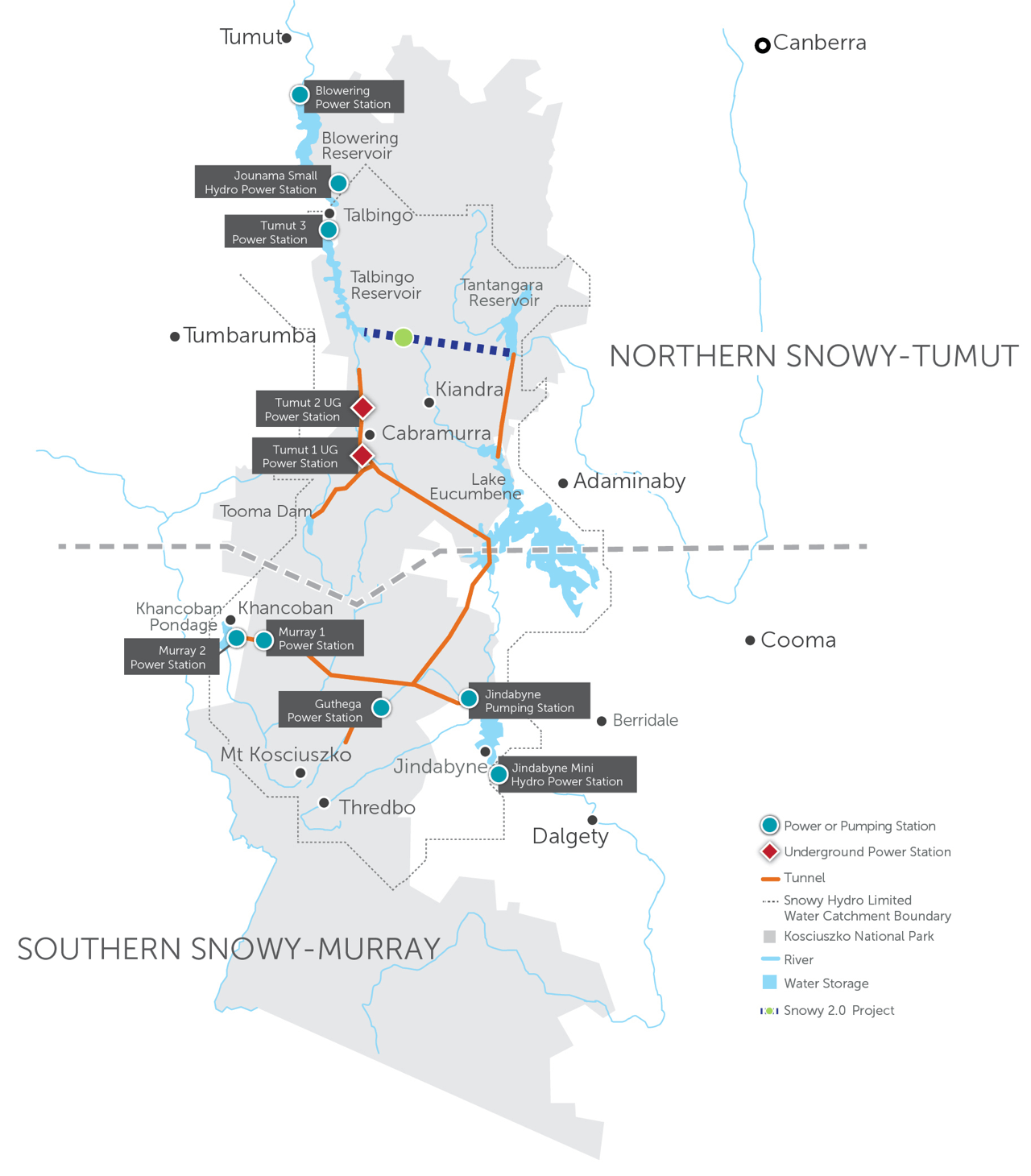
Snowy 2.0 is a pumped hydro- electric expansion of the existing Snowy Scheme that will link the existing Tantangara and Talbingo reservoirs through a series of new underground tunnels and a hydro-electric power station, to be constructed within an underground cavern. Most of the project's facilities will be underground which minimises the project's footprint and impact on the surface. Snowy 2.0 would provide an additional 2,000 MW of dispatchable generating capacity and provide approximately 350,000 MWh of large-scale storage available to the NEM, enough to ensure the stability and reliability of the NEM even during prolonged weather events, such as wind or solar 'droughts'.
Operation of Snowy 2.0 will involve the transfer of water through the underground tunnels and a power station to provide for energy generation, as well as large-scale energy storage that will be available on-demand as quick- start electricity generation at critical times of peak demand including times when intermittent renewable energy output or thermal generation is low. To do this, Snowy 2.0 effectively has two operating modes; energy generating mode and pumping mode (for large-scale energy storage). This concept is shown on Figure ES3.
Principles of Snowy 2.0 Main Works

Where will it be built and operated?
Snowy 2.0 Main Works is in the Australian Alps in southern NSW, about mid-way between Canberra and Albury. Snowy 2.0 Main Works is within both the Snowy Valleys and Snowy Monaro Regional local government areas (LGAs). The nearest large towns are Cooma and Tumut and other nearby towns include Talbingo, Cabramurra, Adaminaby and Tumbarumba. The location of these towns in relation to the project are shown on Figure ES4.
The area in which Snowy 2.0 will be built and operated is referred to in the EIS as the project area, also shown on Figure ES4. The majority of the project area is within Kosciuszko National Park (KNP) however the total disturbance footprint of the project is very small at less than 0.25% of the total park size. KNP is an area recognised for its unique landscapes, recreational and heritage values, as well as the successful co-existence of the Snowy Scheme within this area over the past 65 years. The EIS has described these values and the way the project has been designed to minimise impacts to these values as much as possible.
Snowy 2.0 Main Works project area
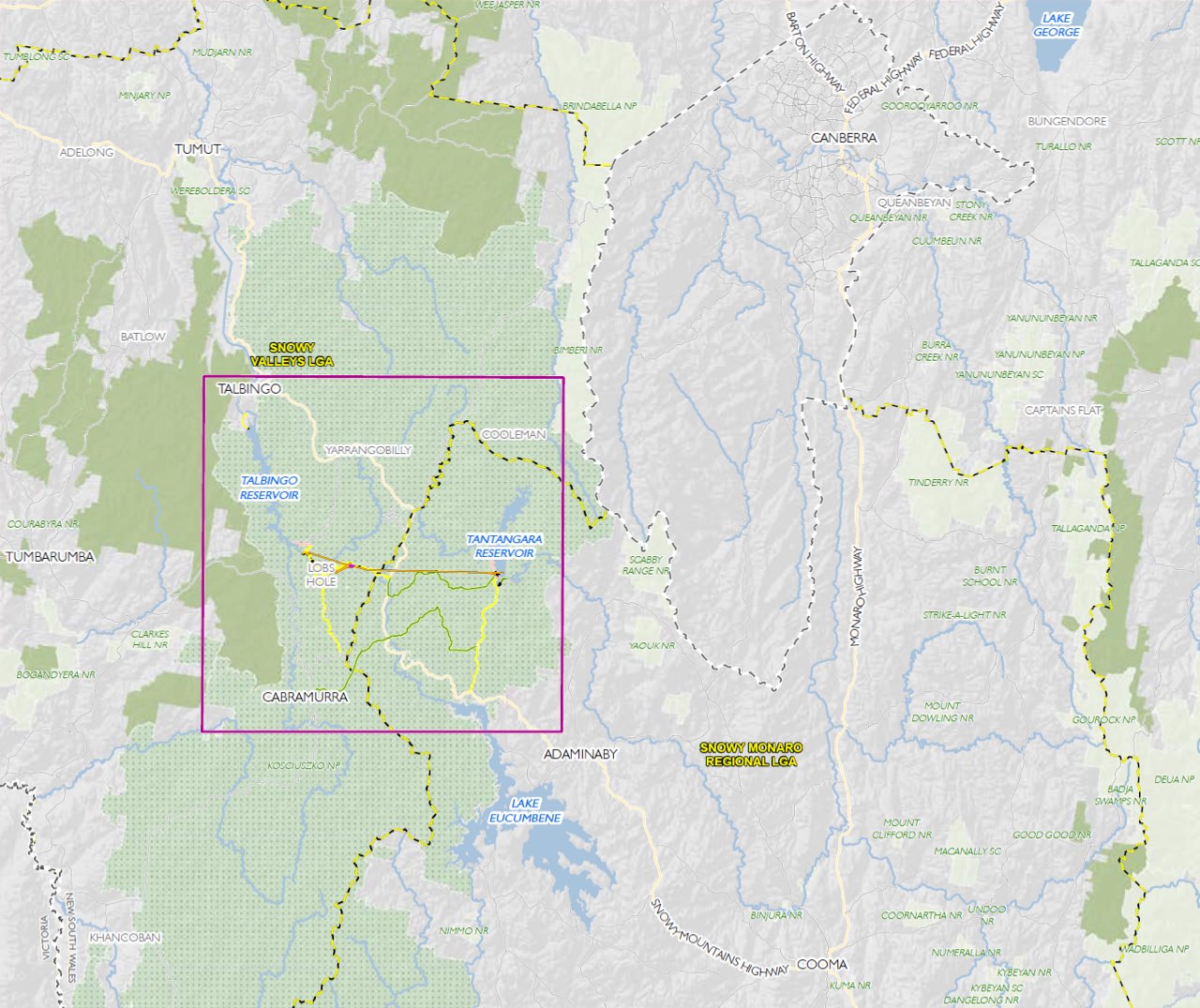
Why is it needed?
Snowy 2.0 is a critical project for NSW and the broader NEM. The project, along with the existing Snowy Scheme, will underpin Australia's transition to a renewable energy future at the lowest cost to consumers. As the transition to renewables accelerates, reliable and stable energy supply cannot be achieved without large-scale energy storage and on-demand generation.
Snowy 2.0 will provide large-scale energy storage and quick-start electricity generation at critical times of peak demand when energy supply is constrained and at times when intermittent renewable energy output is low. This concept is shown on Figure ES5.
Energy storage helps build power system resilience to weather events (including wind and solar droughts) by storing surplus renewable generation for use at times when these resources are scarce and allowing more constant operation of less flexible existing generation. This, in turn, creates a more dispatchable and reliable power system, while helping to keep prices down for consumers.
Pumping water at times of low electricity demand (ie when there is excess supply) means that Snowy 2.0 will have water ready to use for energy generation at times when consumers need it most. Snowy 2.0 will make efficient use of our precious water resources to generate electricity without impacting on downstream water users and environmental flows for the Murray-Darling Basin.
Snowy 2.0 has been declared State significant infrastructure (SSI) and critical State significant infrastructure (CSSI) in accordance with the provisions of the EP&A Act. The declaration of Snowy 2.0 as a CSSI project acknowledges that the project is critical to the State for environmental, economic or social reasons.
Snowy 2.0 daily power demand and generation
Alternatives to Snowy 2.0
Snowy 2.0 Main Works has a number of significant and unique benefits that justify its selection over alternative projects to meet the urgent requirements of the NEM for large-scale storage capability to underpin a stable and secure decarbonisation at lowest cost.
As described more fully in Chapter 3 of the EIS, the NEM is undergoing a paradigm transformation that has been brought about by rapidly decreasing costs of wind and solar generation (known as variable renewable energy or VRE), significant shifts in energy efficiency, coal power station retirements, increasing coal and gas costs and Australia's participation in global commitments to reduce carbon emissions (ie the Paris Agreement).
The NEM urgently needs more on-demand energy and large-scale storage to ensure Australia's secure and stable transition to renewables at lowest cost to consumers. This requirement has been confirmed by a number of independent sources, including the Finkel Review, the Integrated System Plan (ISP) prepared by AEMO, and the recently published ISP Insights paper.
Other opportunities have been identified in NSW and throughout Australia for pumped hydro-electric storage, notably the atlas of pumped hydro-electric storage released in 2017 (Blakers et al. 2017), however the lead time and planning for such projects is extremely complex.
Snowy 2.0 Main Works has the following benefits when compared to alternatives in meeting the immediate requirements of the NEM: no new dams are required, because Snowy 2.0 uses two existing reservoirs which are of a scale that can provide up to 350,000 MWh of storage; Snowy Hydro has secured tenure for the Project and developed the project to a point that it can be delivered by the mid-2020s when storage is required by the NEM; the project will be integrated with and leverage off the capabilities of the existing Snowy Scheme; and the project is located between the two largest load centres in the NEM (Sydney and Melbourne) and in proximity to renewable energy zones in south western NSW and north western Victoria.
Options for pumped storage
A comprehensive assessment of options for the augmentation of the Snowy Scheme was prepared for the Snowy Mountains Scheme Augmentation Ranking Study (SMA 1991). This involved detailed consideration of 10 conventional hydro power alternatives and four pumped storage alternatives.
This study included consideration of a pumped hydro connection between Talbingo and Tantangara reservoirs similar to the Snowy 2.0 alignment, called the Yarrangobilly Pumped Storage Scheme. This option was found to be the lowest cost alternative for large scale pumped hydro energy storage of 18 gigawatt hours (GWh) for 10 day capability. This option was not considered economic at the time in 1991 largely due to the comparative cost of gas turbines. The Yarrangobilly Pumped Storage Scheme was investigated further in early 2017 in the Snowy 2.0 Feasibility Study as it was identified that the economic viability of large scale pumped hydro energy storage had improved significantly, reflecting the change being seen in the energy market with more renewables entering the system and thermal coal progressively retiring. It is this scheme which has been developed into Snowy 2.0.
The purpose of the environmental impact statement
An EIS has been prepared by EMM Consulting Pty Limited (EMM) on behalf of Snowy Hydro to support the CSSI application for approval of Snowy 2.0 Main Works. The EIS is prepared to address the Secretary's Environmental Assessment Requirements (SEARs) issued by the NSW Department of Planning, Industry and Environment (DPIE) on 31 July 2019, which captures the requirements of key regulatory authorities, including the requirements from the Australian Government.
The EIS considers potential environmental, social and economic impacts and benefits of the project, and describes measures identified to minimise and avoid impacts.
The EIS is placed on public exhibition for a minimum of 28 days and provides the community with the opportunity to review the EIS and make a submission. After reviewing submissions, Snowy Hydro prepares a report that responds to the issues raised and makes any required changes to the project. The Australian and NSW governments then carry out a regulatory assessment and determine whether the project should be approved and any conditions to be applied to the consent, should it be granted.
Description of Snowy 2.0 Main Works
Overview
The development of Snowy 2.0 within KNP will result in the creation of a small amount of permanent infrastructure, mostly underground, which is required to operate the project. The design of these infrastructure elements has been integrated into the KNP with careful consideration of its values, as well as maintaining public access to the KNP during construction where safe to do so, and in the long-term once construction has finished.
The key elements proposed as part of Snowy 2.0 Main Works as they are needed for the operation of Snowy 2.0, are shown on Figure ES6 and include:
- an underground pumped hydro-electric power station complex;
- water intake structures at Tantangara and Talbingo reservoirs;
- underground power waterway tunnels, chambers and shafts;
- underground access tunnels;
- fish control structures in proximity to Tantangara Reservoir wall;
- new and upgraded roads to allow ongoing access and maintenance;
- power, water and communication infrastructure, including:
- a cable yard to facilitate the connection of Snowy 2.0 to the NEM transmission network;
- permanent auxiliary power connection;
- permanent communication cables; and
- permanent water supply to the underground power station.
The design and construction of the project will be carried out by Future Generation Joint Venture (FGJV), the contractor appointed by Snowy Hydro. Once construction is complete, Snowy Hydro is responsible for the operation of Snowy 2.0 and its infrastructure. The EIS is based on the design provided by FGJV during the tender process, noting that a detailed design process is now underway.
Snowy 2.0 Main Works has been developed with underpinning principles to avoid and minimise environmental impacts where possible. These principles were implemented through an iterative design integration and assessment approach (DIAA), supported by consultation with numerous expert technical advisors and government agencies. The NSW National Parks and Wildlife Service (NPWS), as land manager of KNP, was consulted with throughout design development and as part of the preparation of the EIS.
For the purposes of predicting environmental impacts of the project, a disturbance footprint has been defined. The disturbance footprint encompasses the extent of physical disturbance likely to be required to accommodate construction activities and infrastructure needed to build Snowy 2.0 Main Works, based on designs provided by FGJV. As detailed design progresses, there may be some elements within the boundaries of the disturbance footprint that need to be relocated or optimised. For this purpose, the disturbance footprint described may be broader than what will ultimately be impacted. In the context of the broader KNP, the overall disturbance footprint is very small, about 0.25% of the total area of KNP. Further detail is provided in Chapter 2 of the EIS. A summary of the project elements is provided in Table ES1 and shown on Figure ES6.
| Project element | Summary of the project |
|---|---|
| Project area | The project area is the broader region within which Snowy 2.0 will be built and operated, and the extent within which direct impacts from Snowy 2.0 Main Works are anticipated. |
| Permanent infrastructure | Snowy 2.0 infrastructure to be built and operated for the life of the assets include the:
|
| Temporary infrastructure | Temporary infrastructure required during the construction phase of Snowy 2.0 Main Works are:
|
| Disturbance area | The disturbance area is the extent of construction works required to build Snowy 2.0. The maximum disturbance area is about 1,680 hectares (ha), less than 0.25% of the total area of KNP. Parts of the disturbance area will be rehabilitated and landformed and other parts will be retained permanently for operation (operational footprint). |
| Operational footprint | The operational footprint is the area required for permanent infrastructure to operate Snowy 2.0. The maximum operational footprint is about 99 ha. This is 0.01% of the total area of KNP. |
| Tunnelling and excavation method | The primary tunnelling method for the power waterway is by tunnel boring machine (TBM), with portals and adits using drill and blast methods. Excavation for other underground caverns, chambers and shafts will be via combinations of drill and blast, blind sink, or raise bore techniques. |
| Excavated rock management | Excavated rock will be generated as a result of tunnelling activities and earthworks. The material produced through these activities will be stockpiled and either reused by the contractor (or NPWS), placed permanently within Tantangara or Talbingo reservoirs, used in final land forming and rehabilitation of construction pads in Lobs Hole, or transported offsite. |
| Construction water and wastewater management | Water supply for construction will be from the two existing reservoirs (Talbingo and Tantangara) and reticulated via buried pipelines (along access roads). Raw water will be treated as necessary wherever potable water is required (eg at accommodation camps).
Water to be discharged (comprising process water, wastewater and stormwater) will be treated before discharge to the two existing reservoirs (Talbingo and Tantangara) as follows:
|
| Rehabilitation | Rehabilitation of areas disturbed during construction including reshaping to natural appearing landforms or returning to pre-disturbance condition, as agreed with NPWS and determined by the rehabilitation strategy. This includes construction areas at Lobs Hole which comprise surplus cut materials. Areas to be used by Snowy Hydro in the long-term may be re-shaped and rehabilitated to maintain access and operational capabilities (eg intakes and portal entrances) |
| Construction workforce | The construction workforce for the project is expected to peak at around 2,000 personnel. |
| Operational life | The operational life of the project is estimated to be 100 years. |
| Operational workforce | The operational workforce is expected to be 8-16 staff, with fluctuations of additional workforce required during major maintenance activities. |
| Hours of operation | Construction of Snowy 2.0 will be 24/7 and 365 days per year. Operation of Snowy 2.0 will be 24/7 and 365 days per year. |
| Capital investment value | Estimated to be $4.6 billion. |
Snowy 2.0 elements
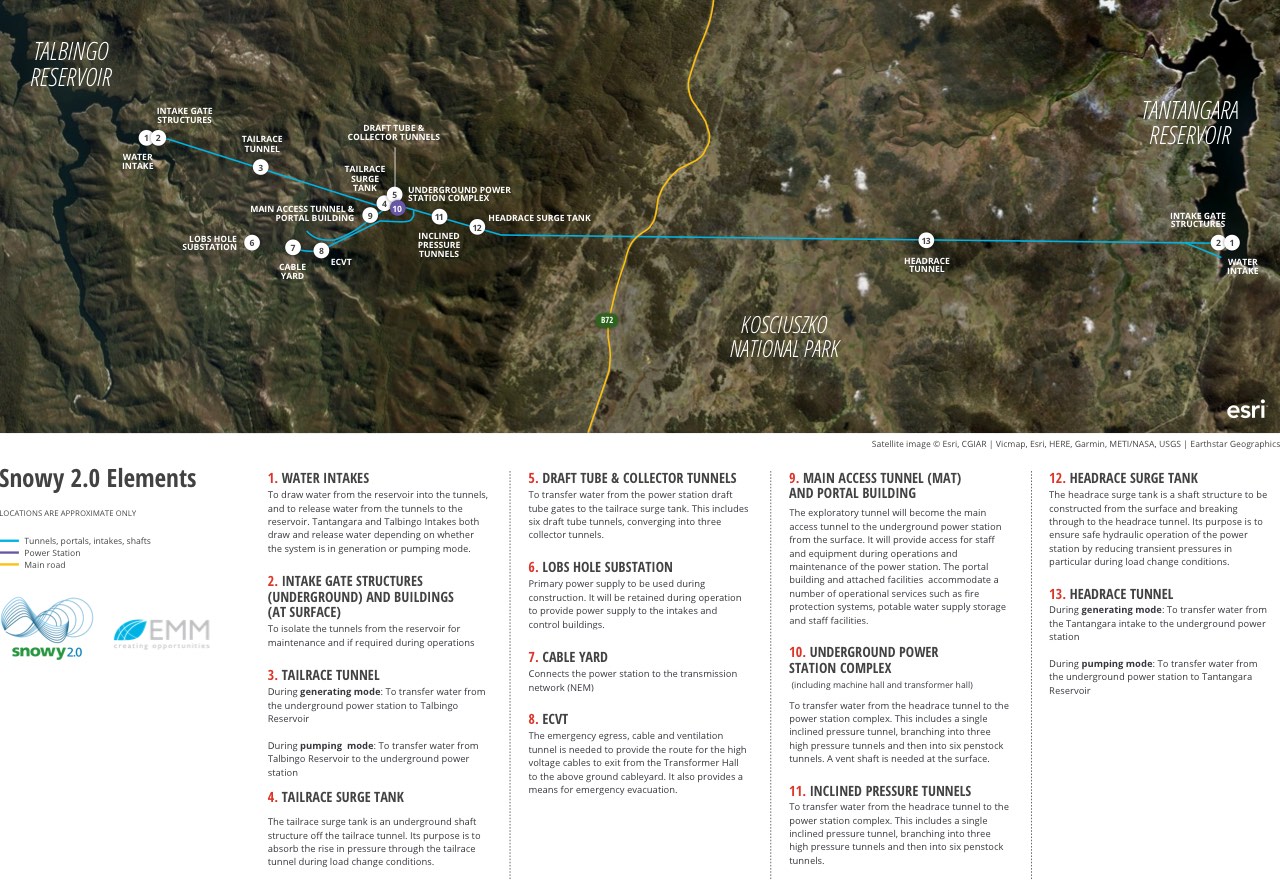
Timing
Snowy 2.0 Main Works will involve phases of construction works to ensure an efficient sequencing into operation, to underpin the secure and reliable decarbonisation of the NEM at lowest cost to consumers. The construction of Snowy 2.0 Main Works has different and overlapping phases during an approximate six-year period, commencing in 2020 (Figure ES7). Progressive commissioning of Snowy 2.0 is expected to commence in 2025 to enable its long-term operation, with the assets having a 100-year design life.
Indicative construction sequencing
Construction components and activities
The construction of Snowy 2.0 Main Works requires multiple techniques and methods to achieve efficient and cost-effective delivery while minimising environmental impacts where possible. Construction primarily involves temporary surface disturbance works through the creation of construction areas to build infrastructure as well as sites where deep excavation works (primarily utilising TBMs) can launch from.
Construction sites
Due to the remoteness of Snowy 2.0 Main Works, construction sites are generally needed to provide construction facilities, storage of plant and equipment and stockpiling of materials, provide access to underground construction sites and to provide onsite accommodation at camps for the construction workforce. Most construction sites and infrastructure to be established will be temporary in nature, removed and rehabilitated once the work is finished.
Some infrastructure will be retained permanently and used for operation. This includes barge launch ramps (for maintenance of intakes), water management infrastructure (retained at tunnel portals), communication and power supply (to provide services to permanent elements), and access roads needed during operation.
Key construction elements of the project are shown in Figure ES8.
Snowy 2.0 construction elements
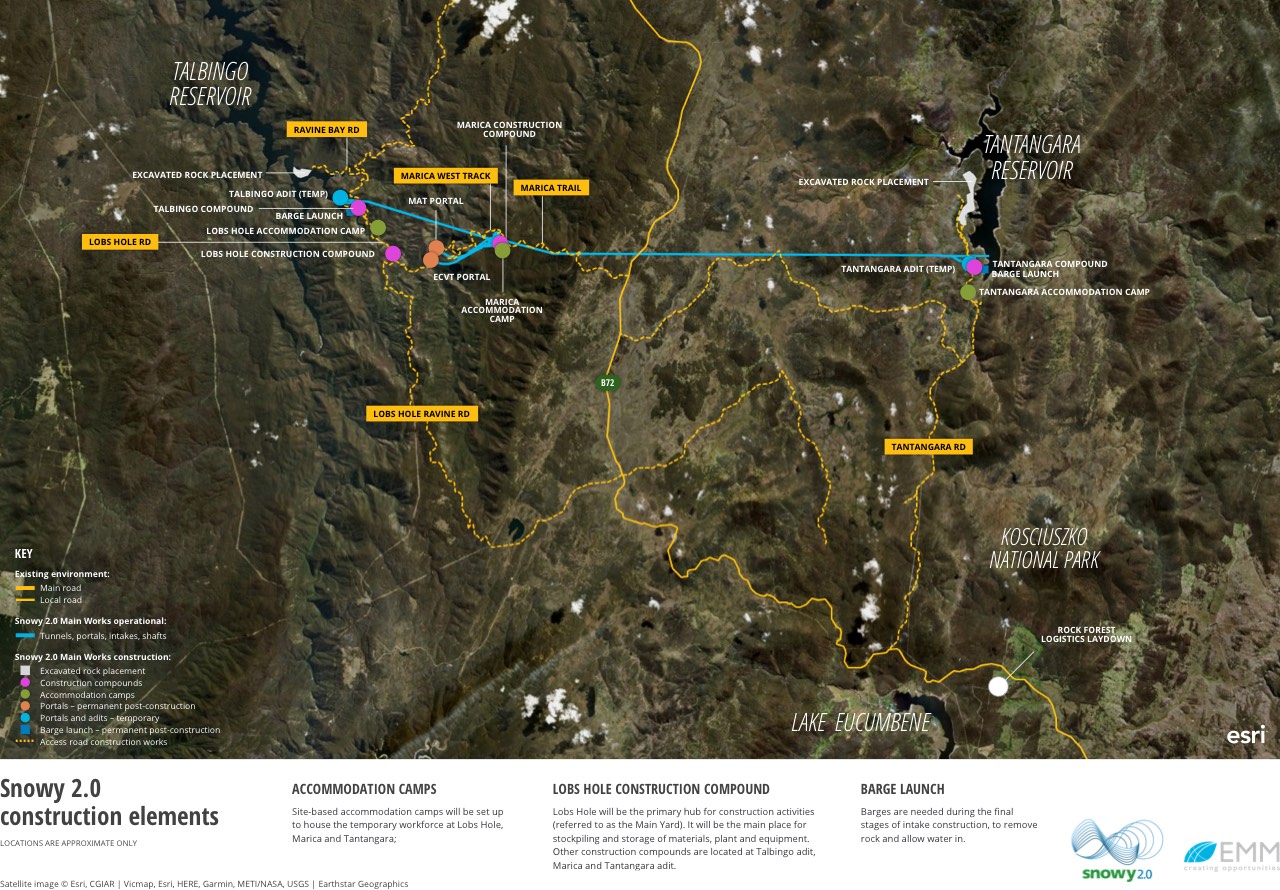
Tunnelling methods
The primary tunnelling method for the power waterway is by TBM, with portals and adits using drill and blast methods. Excavation for other underground caverns, chambers and shafts will be via combinations of drill and blast, blind sink, or raise bore techniques. The proposed TBM approach is shown in Figure ES9.
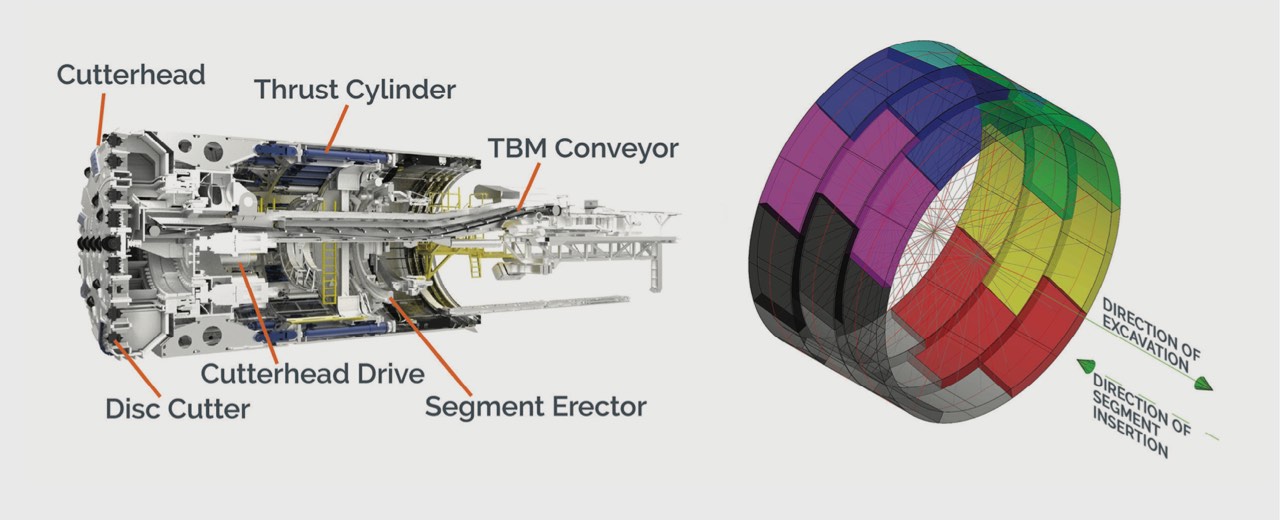
A typical tunnel boring machine
Primary excavation methods - drill and blast and tunnel boring machine (TBM)
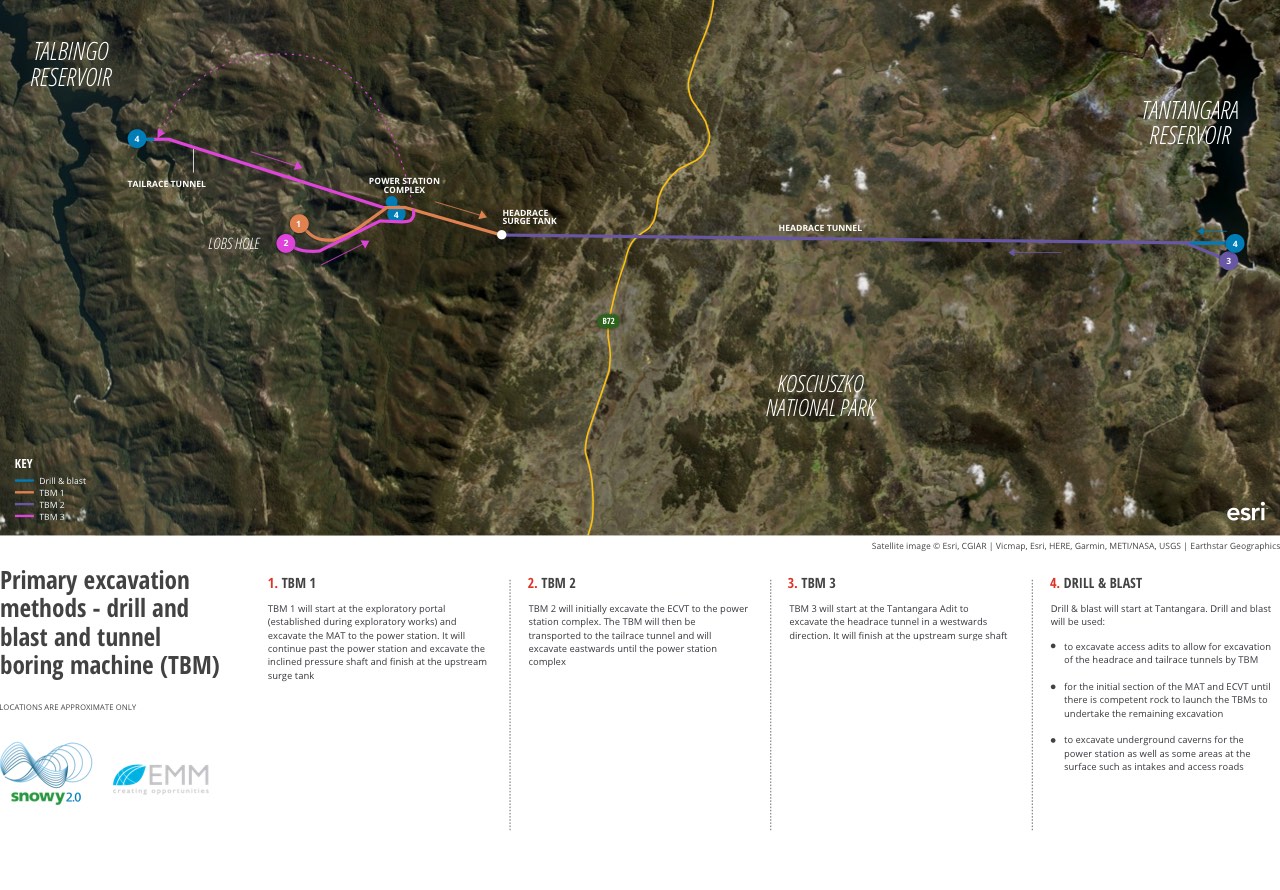
Management of excavated rock
Excavated rock will be generated as a result of tunnelling activities and earthworks (approximately 9 million cubic metres (Mm3) of unbulked excavated material).
The strategy for management of excavated rock will aim to maximise beneficial reuse of materials for construction activities. Beneficial re-use of excavated material may include use for road base, pad establishment, selected fill and tunnel backfill and rock armour as part of site establishment for construction areas. Excess excavated material that cannot be re-used during construction will be placed within Tantangara and Talbingo reservoirs. During the construction phase, surplus cut materials used to establish construction pads within Lobs Hole may be used to assist with landforming and rehabilitation.
The management of excavated material and placement has been divided into two management systems based on the east (Tantangara) and west (Talbingo) sides of the project area. Excavation work at Marica will be managed by the Tantangara management system. This is shown in Figure ES10. The predicted excavated material is categorised according to the main methods of tunnel excavation, TBM and drill and blast.
Excavated material managed at Tantangara will be temporarily stockpiled where it is generated or at the identified temporary stockpile area, and then transported for either beneficial re-use or placement within Tantangara Reservoir.
On the Talbingo side, excavated material will be stockpiled at Middle Bay and the MAT. From the stockpile locations excavated material would then be transported for either beneficial re-use or placement within Talbingo Reservoir.
i. Placement in Tantangara Reservoir
Placement within Tantangara Reservoir is proposed within the active storage of the reservoir from its minimum operating level (MOL) to just above full supply level (FSL). The proposed placement area only takes up 3% of the area of the reservoir at FSL.
Appropriate erosion and sediment control measures, such as temporary diversion drains will be installed before the start of placement activities.
The final elevation of the placement areas will be above FSL to allow for permanent rehabilitation of the landform. This is to prevent inundation of the placement area when the reservoir is at capacity. Further engagement with NPWS will be carried out regarding the end use of these areas, such as recreational areas.
ii. Placement in Talbingo Reservoir
Placement within Talbingo Reservoir is proposed below MOL and within active storage from the bed of the reservoir to just above FSL. The proposed placement area only takes up 1% of the area of the reservoir at FSL.
Placement of excavated rock within Talbingo Reservoir involves placing materials from the northern edge of Ravine Bay into the reservoir. Placement activities will commence with the installation of a silt curtain to reduce turbidity within the reservoir.
A nominal 1 m layer of rock armouring will be placed above MOL to protect the slope of the submerged placement area. The placement area will be rehabilitated to about 1 m above FSL to allow for revegetation.
iii. Placement in Lobs Hole
The continued use of the construction compound at Lobs Hole requires considerable materials in the form of surplus cut to create safe and stable areas for construction. Following completion of construction activities for Snowy 2.0 Main Works, it is proposed to retain these construction pads and be landformed, reshaped and rehabilitated to a final use agreed with NPWS.
| Eastern Management System (Tantangara) | |
|---|---|
| Excavated for sub-aqueous placement and active storage | 2,800,677 m3 |
| Reused in permanent structures* | 826,742 m3 |
| Western Management System (Talbingo) | |
|---|---|
| Excavated for sub-aqueous placement | 2,834,212 m3 |
| Reused in permanent structures* | 1,140,573 m3 |
| Land forming | 1,000,000 m3 |
* e.g. roads and operational pads - MAT, ECVT, etc All figures in m3 (unbulked)
Excavated materials management systems
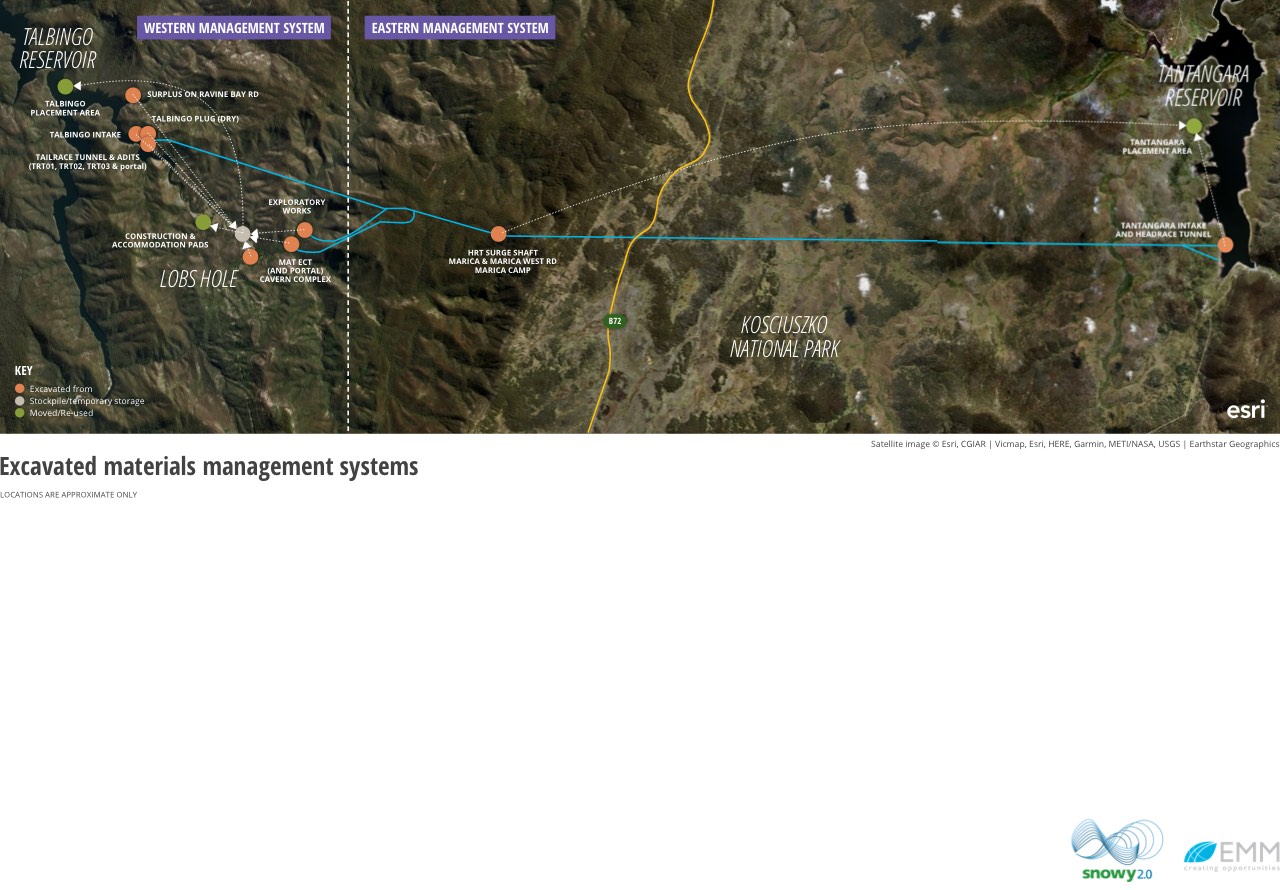
Road works and access arrangements
Access works are required to facilitate the safe movement of plant, equipment, materials, including the transport of oversized loads as required, and the transport of excavated material between the tunnel portals and the excavated rock emplacement areas., Construction workers will also be transported into and out of construction sites via internal access roads.
Construction of Snowy 2.0 Main Works will require use of existing roads and tracks within KNP, including some where public access will need to be restricted for the entire construction period for safety reasons. Once construction has finished, Snowy Hydro will either return the existing roads to a standard agreed with NPWS or rehabilitate constructed roads and return access to NPWS and the public. Some new roads will be constructed to provide access to permanent infrastructure with these roads maintained in the long term and some public access restrictions signposted. The primary access roads to the construction areas are shown in Figure ES11, as well as public access arrangements during construction and operation.
Snowy Hydro has been liaising with NSW Roads and Maritime Services (RMS) to understand the existing program of works within the region to be carried out during the planned construction of Snowy 2.0 Main Works and the requirements of the project. Road works required for the Snowy 2.0 Main Works are as follows:
- widening of the intersection with Snowy Mountains Highway and Tantangara Road – to allow safe passage for light and heavy vehicles through this intersection;
- new intersection with Snowy Mountains Highway and the Marica Trail – to allow direct access to construction areas for project-related traffic;
- new access from Rock Forest with Snowy Mountains Highway – to allow ingress and egress from the Rock Forest property to the Snowy Mountains Highway for light and heavy vehicles; and
- widening of the intersection with Link Road and Lobs Hole Ravine Road - to allow direct access to construction areas for project-related traffic.
Working arrangements
Construction of Snowy 2.0 will be 24/7 and 365 days per year. The construction workforce is expected to peak at around 2,000 personnel in 2023 but will fluctuate over the six-year construction schedule as needed to align with the work activities.
Personnel working on the project will generally not be permitted to drive to the camps, in order to reduce the volume of traffic on the roads and ensure worker and public safety. They will be transported from designated towns and airports to the accommodation camps by project-supplied buses. The site roster for personnel will be developed as part of FGJV's human resources and recruitment initiatives. However, it is expected to be 20 days on, 10 days off, with two shifts of 12 hours each, or similar arrangement.
Public access during construction and operation
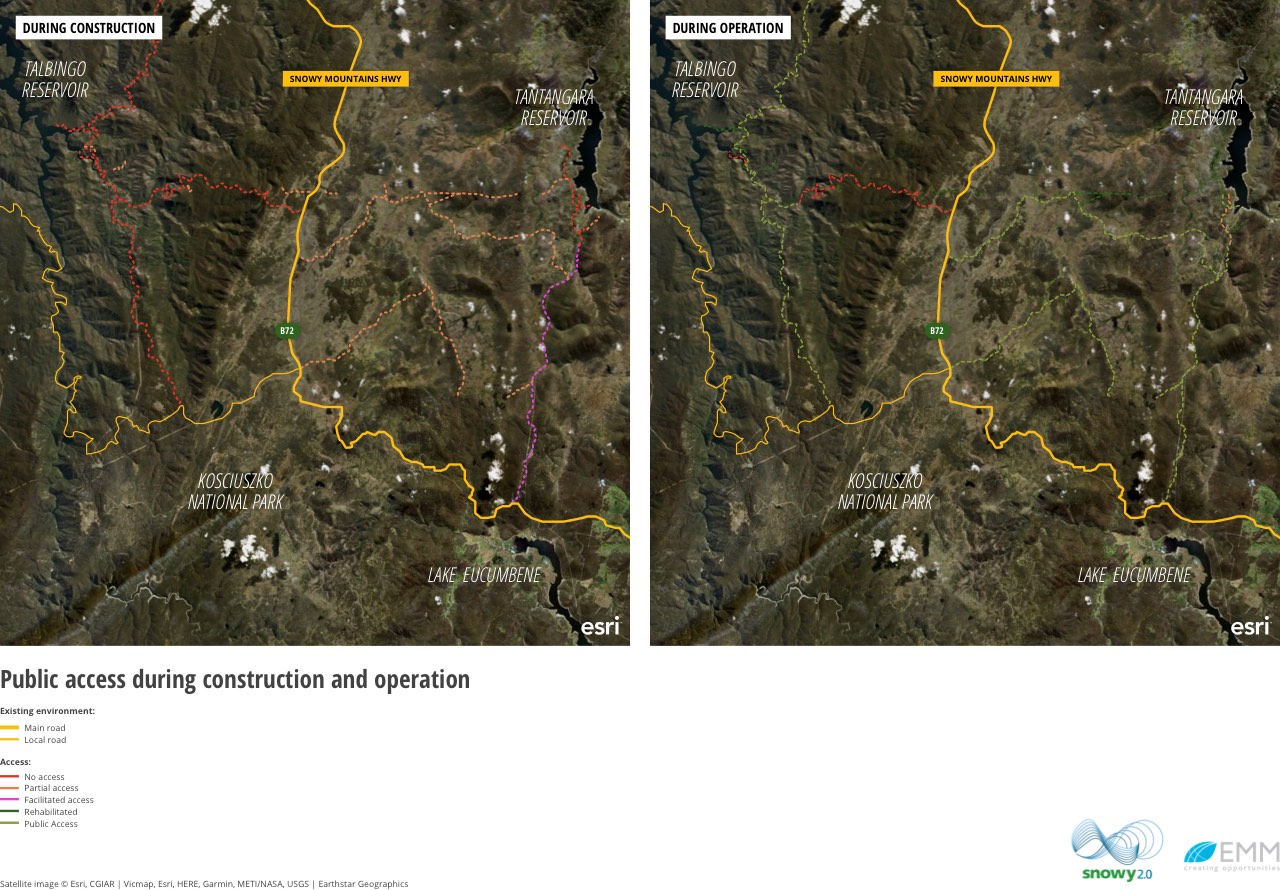
Operational functions and activities
Reservoir operation and maintenance
Following the commencement of the operation of Snowy 2.0, both Tantangara and Talbingo reservoirs will have increased operational functions. Tantangara Reservoir will have the additional operational functions of acting as a head storage for generation from the Snowy 2.0 power station and also acting as a storage for water pumped up from Talbingo Reservoir. Talbingo Reservoir will have the additional operational function of acting as a tail storage from Snowy 2.0 generation.
Due to these additional operational functions proposed for Tantangara and Talbingo reservoirs, the short and longer term water levels in both reservoirs, as well as the rates of water level rise and fall, are expected to experience some degree of change compared to the historical operations. Importantly however, under Snowy 2.0:
- the water levels in both reservoirs will remain within the MOL and FSL approved for the existing Snowy Scheme; and
- there will be the same volume of water in the Snowy-Tumut Development as a whole. The flexible storage of that water across the storages within the Snowy-Tumut Development below FSL is also part of the approved existing Snowy Scheme.
The inundation of land below the FSL and the variability in storage levels has existed within the existing Snowy Scheme since the scheme was implemented. These operations have the benefit of the existing Scheme development authorisations granted for the purposes of the EP&A Act, Environment Protection and Biodiversity Conservation Act 1999 (Cth) (EPBC Act) and the National Parks and Wildlife Act 1974 (NSW) when the existing Scheme was corporatised by the Commonwealth, New South Wales and Victorian governments in 2002, (see Part 7 of the Snowy Hydro Corporatisation Act 1997 (NSW) (SHC Act)). This will continue under Snowy 2.0.
Maintenance activities required for Snowy 2.0 will be integrated with the maintenance of the existing Snowy Scheme. Permanent access to Snowy 2.0 infrastructure is required for these activities. During operation, several service roads established during construction will be used to access surface infrastructure including the power station's ventilation shaft, the water intake structures, and the headrace tunnel surge shaft. Permanent access tunnels (the MAT and ECVT) will be used to enter and exit the power station. For some roads, permanent access by Snowy Hydro will require restricted public access arrangements. These access arrangements are shown on Figure ES11.
Mitigation of impacts through project design
Implementation of the DIAA process to optimise the design resulted in some significant environmental improvements and outcomes. Primary design improvements included significant reductions in disturbance areas avoiding impacts to endangered species and vegetation communities, heritage items, geodiversity features, and sensitive watercourses. The overall excavated rock volumes have also been reduced through project design (such as reducing lengths of tunnels) resulting in less material needing to be placed in reservoirs and on land.
Some key residual risks identified warranted further design measures to be incorporated as part of the project to further reduce risk of potential long term impacts. These include:
- instream barrier to prevent the potential upstream migration of Climbing galaxias, a native but translocated species, into the habitat of the critically endangered Stocky galaxias;
- a filtration station/s to screen pest fish species from being discharged through the Murrumbidgee - Eucumbene Tunnel and Tantangara Reservoir wall is proposed at Tantangara Reservoir. While it is considered highly unlikely to occur as a result of the project, this is aimed to avoid potential secondary transfer of any pest fish species that may establish in Tantangara Reservoir.
Rehabilitation and final landform
A Rehabilitation Strategy has been developed for the project and identifies final land use domains for areas impacted during construction. This includes returning the land to native vegetation or retaining land needed for operation. Some areas have been identified as future recreation sites, subject to consultation with NPWS.
Landform design and planning has been carried out to identify opportunities for the reuse of excavated material in rehabilitation and in final landforms which complement the surrounding landscape of KNP and provide recreational opportunities for users of KNP where appropriate. Reuse of excavated material in final landforms will be subject to geochemical testing to confirm it is suitable to remain in situ. Any unsuitable materials will be remediated and removed from the areas to be rehabilitated. An example of future recreational opportunities that could be integrated into rehabilitation and landforming is shown in the artist impression.
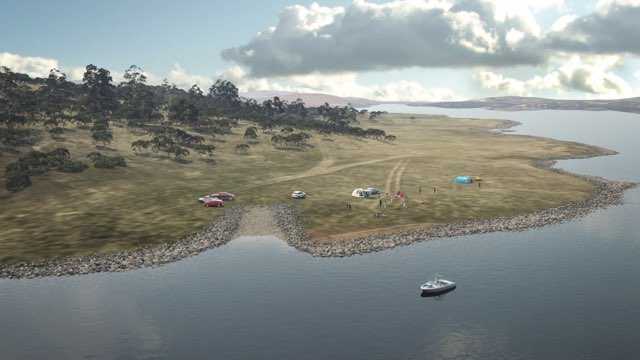
Artist impression of Tantangara Reservoir: rehabilitated full supply level optimised for recreational use
Strategic and statutory context
The changing energy system and the benefits of Snowy 2.0 in the NEM
Changing energy system
The strategic context of Snowy 2.0 relates to its critical significance for the NEM, key State and Commonwealth government plans and policies, and economic, social and environmental trends driving a paradigm shift in the energy market.
During the Feasibility Study for Snowy 2.0 and in the lead up to its final investment decision (FID), Marsden Jacob Associates (MJA) carried out independent market modelling to understand upcoming trends and the future NEM in which Snowy 2.0 will operate. The findings of these studies confirm the strategic justification and need for Snowy 2.0 to provide large- scale storage that facilitates firming and reliability to the NEM, as the NEM decarbonises over the next few decades.
While the MJA modelling in the lead up to FID in late 2018 is still very relevant and underpins the strong economic case for the project since this time, the energy market has evolved and changed much more quickly than originally anticipated even just a year ago. The likelihood of coal-fired generators closing earlier than previously anticipated is increasing (Aurora Energy Research 2019) and concurrently, the rapid uptake of intermittent renewables due to favourable economics is changing the energy market landscape. For example, investment in large-scale renewable energy projects doubled in 2018 compared to a previous record- breaking 2017, increasing from $10 billion to $20 billion (Clean Energy Council 2019).
NSW is likely to have one of the greatest requirements for energy replacement and capacity, as several coal-fired power plants are confirmed to be retired within the next decade. As the likelihood of new coal-fired power stations is considered to be low, much of the replacement of coal-powered generation will be from renewable sources and to a lesser extent gas.
Key system changes in the NEM
Source: AEMO
Key benefits of Snowy 2.0 for the NEM
In recognition of the need to manage the transition and future energy mix in the NEM, Snowy 2.0 was declared CSSI by the former NSW Minister for Planning under the NSW EP&A Act in March 2018. It was declared as critical for the energy security and reliability needs of NSW. At the time of the declaration the Minister stated that Snowy 2.0 was "essential for the future security of our energy system, the economy and the environment." The declaration signifies the critical role that Snowy 2.0, together with the upgrades to the NSW transmission network, will play in providing reliable on-demand energy and large-scale storage to NSW as it transitions to a low emissions economy.
Snowy 2.0 is the largest committed renewable energy project in Australia. By expanding the current Snowy Scheme's renewable energy capacity by almost 50%, the NEM will be served with an additional 2,000 MW generating capacity. In terms of the future energy market, the key benefits of Snowy 2.0 are summarised as follows:
- Snowy 2.0 provides low emission on-demand energy and will underpin the continued decarbonisation of the economy;
- Snowy 2.0 provides deep storages to allow more flexibility to respond to seasonal variability when compared to other VRE and batteries;
- Snowy 2.0, being a closed system, can move water between reservoirs and not rely on natural inflows that may vary seasonally, offering valuable seasonal storage and insurance against drought risk. This is because Snowy 2.0's pumping capabilities work in a 'closed' system - water is recycled between the two dams so the same water can be used to generate power more than once, making the most of available water;
- Snowy 2.0 will have the capability to run for over seven days continuously before it needs to be 'recharged'. By comparison, small and large-scale batteries have limited storage (typically one to four hours);
- Snowy 2.0 will improve the overall efficiency of the NEM by absorbing and storing excess energy from the system at times of excess demand (through pumping) and generate at the critical times of peak times; and
- Snowy 2.0 has a 100 year design life and will generate power for the generations to come.
The net result of Snowy 2.0 being developed is improved market efficiency, more reliable market operation, the provision of large-scale energy storage, encouragement of more variable renewable energy generation to enter the NEM and lower emissions at the lowest cost.
Key benefits of Snowy 2.0 in the NEM
Source: AEMO
Statutory requirements
Snowy Hydro is a company incorporated under the Commonwealth Corporations Act 2001, with an independent board of directors and all shareholding held by the Australian Government.
The existing Snowy Scheme is permitted to operate within land that is reserved as a national park under the provisions of the SHC Act. Snowy Hydro has rights to access and operate the existing Snowy Scheme within the KNP in accordance with the Snowy Park Lease granted by the NSW Minister for the Environment, and the Snowy Management Plan. Snowy Hydro also operates the Snowy Scheme under a water licence administered by DPIE that allows for water collection, storage, diversion and release in order to generate electricity (the Snowy Water Licence).
Snowy 2.0 (including Snowy 2.0 Main Works) has been declared to be SSI and CSSI. Therefore, the project requires assessment and approval under Part 5, Division 5.2 of the NSW EP&A Act before it can proceed. The NSW Minister for Planning and Public Spaces is the determining authority for the Snowy 2.0 Main Works.
Snowy 2.0 Main Works has been determined to be a controlled action under the EPBC Act and therefore requires approval from the Commonwealth Minister for the Environment. Under the EPBC Act, Snowy 2.0 Main Works will be assessed by the accredited assessment process under Part 5, Division 5.2 of the NSW EP&A Act. Potential impacts of the Snowy 2.0 Main Works on matters of national environmental significance and the environment generally are considered throughout the EIS.
Other licenses, approvals and permits required for the project to be carried out are detailed in the EIS.
Engagement
Engagement for Snowy 2.0 Main Works
Over many decades Snowy Hydro has lived, worked and invested in the communities it operates in. The company is a sponsor and supporter of community groups, events and activities. Snowy Hydro's high level of local activity, regular interaction with stakeholder groups, and participation on emergency management groups ensures the community and stakeholders have regular opportunities to engage with the business.
Snowy Hydro engaged with key stakeholders throughout development of the project, being governments, local community, local industry and business groups, environmental groups, the Aboriginal community and media. Engagement activities started early on during project development from 2017 onwards. Engagement on Snowy 2.0 Main Works is the continuation of a conversation that builds on the extensive Feasibility Study and Exploratory Works consultation and engagement. Snowy Hydro's engagement approach is two-way: with Snowy Hydro sharing information and then listening to and taking onboard stakeholder feedback. The EIS addresses how stakeholder feedback has been considered and incorporated into the project plans and activities.
Key issues raised and how they have been addressed
Many topics and comments were received throughout the course of the engagement period, which are documented in the Stakeholder Engagement Report provided with the EIS.
Feedback from the community on Snowy 2.0 has been overwhelmingly positive. Some of the issues identified and raised by these stakeholders are specific to a geographic location or an individual. Other issues that are raised at community events (which are all open to anyone to attend) are made by someone on behalf of a local community group and reflect a special interest group's view. Issues raised during agency consultation were specific to the regulatory role of those agencies. There were common themes amongst all stakeholder groups consulted with. Key themes and topics raised during engagement with community, industry groups and government agencies include:
- environmental impacts to the KNP, including local water quality and impacts to flora and fauna;
- opportunities for local businesses to get work on Snowy 2.0;
- the flow on economic benefits of the project for the Snowy Mountains region;
- impacts to recreational activities including fishing and horse riding in the KNP;
- potential for fish transfer and impact to fish habitat;
- excavated rock placement in the Tantangara Reservoir;
- road closures and increased traffic during construction; and
- support for Snowy Hydro's investment in more renewable energy for future generations.
The project has addressed these potential issues through preparation of the EIS including the development of mitigation measures and commitments for the project.
Future engagement
A stakeholder engagement framework has been developed for Snowy 2.0 that provides a structure for the management of stakeholder relations and communication related to the project. The proposed engagement approach is tailored to each stakeholder group, is flexible and will be reviewed regularly following Snowy 2.0 engagement activities. The proposed approach to community engagement if the project is approved, is to focus on providing engagement activities and communication materials that provide up to date project information to those stakeholders likely to be affected during construction. It will also ensure there are opportunities for stakeholders, in particular the community, to communicate their concerns with the project.
A summary of the key engagement activities proposed if the project is approved is provided in Figure ES14. The focus for communications and stakeholder engagement in the next phase is around project construction.
Proposed engagement approach
Assessment of impacts
Overview
The purpose of the EIS is to identify and address all key environmental, social and economic impacts arising from the Snowy 2.0 Main Works. These key impacts have been identified through a rigorous environmental impact assessment process having regard to the SEARS, the requirements of the NSW EP&A Act and through engagement with stakeholders on matters that interact with the project. Measures proposed to mitigate the unavoidable impacts of the Snowy 2.0 Main Works are also detailed in the EIS.
Water
Impacts to water arise primarily during construction due to tunnelling of the power waterways and underground power station, placement of excavated rock within the reservoirs, and construction related impacts on surface water due to disturbance and clearing of land. The need to manage water discharge and quality during construction is also a high priority for minimising impacts to the surrounding environment.
Groundwater drawdown is predicted to occur with potential stream flow impacts. However, these impacts will be reduced by proposed grouting of the tunnels during construction. Drawdown has the potential to impact aquatic and terrestrial ecology and these have been considered in respective assessments. While these impacts are expected to be greatest during construction, some drawdown is also predicted during operation. The existing groundwater monitoring network will be expanded, and a Trigger Action Response Plan developed to provide guidance on appropriate management and remedial measures to be implemented.
Placement of excavated rock in reservoirs will result in elevated levels of suspended solids and other water quality parameters throughout construction, primarily for a period following placement before levels return to baseline. Management of these impacts will be through use of silt curtains and adapting the placement method and timing as much as is reasonable and feasible to do so.
Impacts to local watercourses are predicted from runoff or disturbance from construction sites. These impacts will mainly be limited to the start of construction, and in small waterways depending on seasonality, until sedimentation basins are fully established and operational.
Ongoing consultation with key agencies will be carried out to ensure mitigation and management measures are adaptable and frequently evaluated to ensure achievable environmental outcomes.
While local effects will likely occur as a result of the project, the regional effects on the catchment surface water flows, catchment water quality and regional groundwater resources are insignificant.
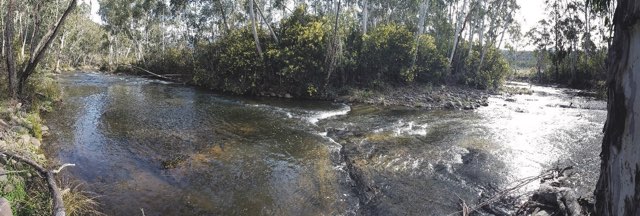
The Yarrangobilly River at Lobs Hole, upstream of Lobs Hole Ravine Road crossing
Biodiversity (terrestrial and aquatic ecology)
Based on the biodiversity assessments that have been completed to identify the presence of Commonwealth and State listed communities and species, and after avoidance and mitigation measures are implemented, the residual impacts to biodiversity will be primarily associated with the loss of some native vegetation and fauna species habitats. In particular, Alpine Bogs and Fens are a threatened ecological community (listed under the EPBC Act) and high value groundwater dependent ecosystem located across the Plateau, with some impacts predicted based on current groundwater modelling for the project.
While the project will result in direct impacts to terrestrial vegetation and habitat, these impacts have been minimised and where possible avoided through the DIAA process. This avoidance and minimisation process will be further refined during detailed design. Where impacts cannot be avoided or minimised, appropriate offsets will be determined in line with the Offset Strategy that will focus on projects and activities to enhance the values of KNP.
Terrestrial surveys in the KNP carried out for the project have already made a significant contribution to improving the understanding and ecological extent of several threatened species, some of which had only very limited record before the Snowy 2.0 surveys commenced. In some instances, many more records of threatened species or new sub-populations have been found.
Key impacts to aquatic ecology include loss or modification of habitat, impacts to aquatic species, and changes to water quality. These impacts primarily result from placement of excavated rock in Talbingo Reservoir and predicted turbidity and settlement of sediment over key fish habitat, disturbance of waterways and transfer of water between the two reservoirs which have different chemistry/characteristics.
The low/small potential for fish transfer from Talbingo Reservoir to Tantangara Reservoir and other downstream catchments is a key risk that has been minimised through design, with inclusion of an instream barrier on Tantangara Creek to limit Climbing galaxias from entering the upper Murrumbidgee catchment, and secondary controls placed near Tantangara Reservoir wall to restrict pest species from being transferred to the lower Murrumbidgee catchment and Lake Eucumbene and connected reservoirs. While the risk of this occurring is extremely low to negligible, detailed scientific investigations have not been able to categorically rule out this potential risk.
Unavoidable impacts to aquatic ecology will similarly need to be offset and will form part of the overarching Offset Strategy for enhancing the values of KNP and determined through consultation with NPWS and DPIE.
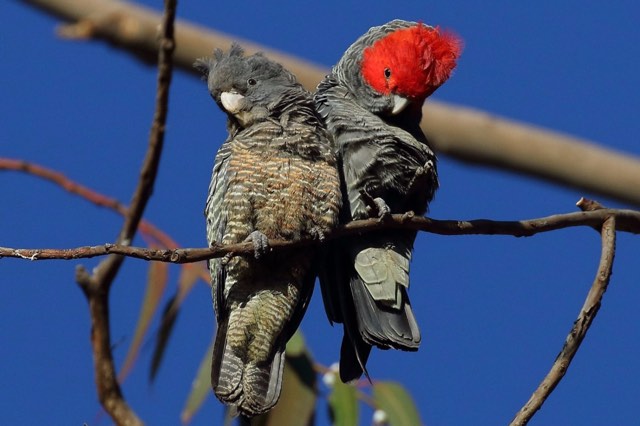
The Gang-gang Cockatoo (Callocephalon fimbriatum) was found to be common across the project area
Land
Impacts to land have been considered through the design of the Snowy 2.0 Main Works and risks and sensitivities for contamination, soils and land capability, rehabilitation and geodiversity were assessed and suitable management measures identified. With the implementation of the proposed management measures it is expected that the project will minimise impacts to land and achieve an end land use consistent with the KNP Plan of Management (PoM). This includes the preparation of a Rehabilitation Strategy, which provides objectives for successful revegetation in the unique alpine environment and landforms commensurate to the natural environment.
Key contamination matters relevant to land identified include contamination risks associated with Potential Acid Forming (PAF) material at Lobs Hole and Naturally Occurring Asbestos (NOA) materials at the Plateau that may be encountered during excavation works. Appropriate management measures and protocols are proposed to minimise contamination risks, including the use of a multi-modal TBM to safely manage NOA during tunnelling activities.
The proposed construction works have potential to impact on three known geodiversity sites and two potential newly identified geodiversity sites. Measures will be implemented to minimise impacts as far as possible, such that the geodiversity values of the impacted sites will be maintained. There is also opportunity to provide some enhanced viewing areas of these geodiversity sites at completion of construction work, in consultation with NPWS.
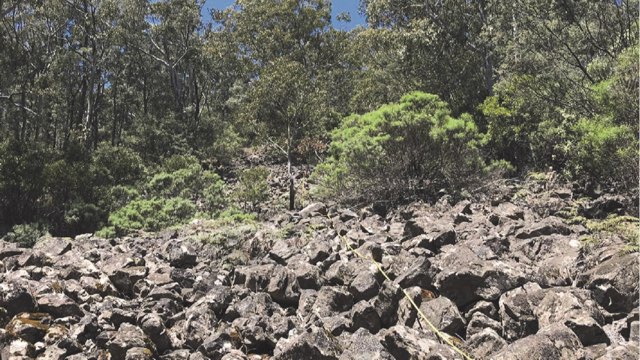
Block stream studied along Lobs Hole Ravine Road
National heritage
Overall Snowy 2.0 Main Works will have a minor impact on values of the Nationally listed 'Australian Alps National Park' (AANP). Landscape character impacts have been considered and are higher during construction, but suitable rehabilitation of disturbed areas will reduce these impacts during operation. Snowy 2.0 Main Works will impact values of the AANP relating to geodiversity, ecology, cultural heritage, landscape character and recreation. However, these impacts are within a manageable framework that will be minimised and result in only limited impact to official values of the AANP listing, which will be confined to the very small areas within the project disturbance footprint and a couple of vantage points overlooking the affected landscapes.
Importantly, positive impacts to the values of the AANP will also be experienced, including the additional scientific research that has been completed for Snowy 2.0 Main Works which will be built upon subsequent to project approval. This includes significant ecological findings (eg larger population and distribution of the critically endangered Smoky Mouse) and increased evidence of Aboriginal and historical occupation of the KNP. Furthermore, post construction there will be enhanced recreational values through improved recreational access and facilities within the KNP, subject to ongoing consultation with NPWS.
The project is assessed to have a direct positive impact on the National heritage values of the Snowy Scheme through further developing the civil engineering project started in 1949 and is likely to reignite an interest in the scheme and its symbolism relating to a multicultural, independent and resourceful Australian identity. Overall the project represents an expansion of a major engineering achievement which is a key value of the Snowy Scheme.
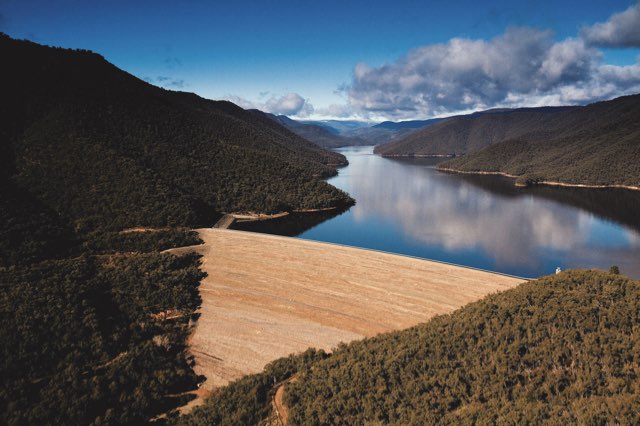
Existing Snowy Scheme set against the landscape of the KNP
Aboriginal and historic heritage
The survey and assessments completed for the project have contributed significantly to our understanding of the archaeological record of the KNP and evidence of Aboriginal occupation and adaptations to cold climate environments. Although impacts to Aboriginal sites and objects are unavoidable in all instances, mitigation strategies including salvage excavation will aim to recover a representative sample of the areas subject to impacts and contribute further to our understanding of Aboriginal occupation. The Aboriginal community have, and will continue to be, consulted about the affected Aboriginal cultural heritage values and their management.
The historical assessments for the project have also contributed significantly to our understanding of the archaeological record of the KNP and the range of historical events that have left archaeological traces across the landscape. Although some impacts to historical items and landscapes are unavoidable, mitigation strategies including the avoidance of Washington Hotel and Ravine Cemetery sites, and salvage excavation and archival recording where warranted, will aim to contribute further to our understanding of historical occupation and events.
Transport
The main transport route to the project is via the Snowy Mountains Highway from Cooma. The project will increase traffic along this route to allow the delivery of materials to site and there are sections of this route that will necessitate upgrade as a result. New intersections are also required to connect proposed access roads with the external road network, and these intersections will be designed and managed to meet required road safety criteria. Traffic management will be implemented during construction to ensure appropriate road maintenance is safely carried out, and traffic control and community consultation is carried out to ensure public safety.
Further consideration of traffic and transport impacts will be carried out as part of the project design and scheduling. It is anticipated that in the long term, improved access infrastructure will be provided within the project area and wider region.
Barges are needed on Tantangara and Talbingo reservoirs as part of intake construction and barge launch areas are proposed to be retained for operation and maintenance. This presents safety risks that may arise from interaction with recreational boating activities. The use of navigable waters has been considered for both reservoirs and suitable management measures identified to ensure public safety during construction and operation. Some public access will be restricted during construction and operation to ensure this, but careful planning has been undertaken to minimise the extent of impacts.
Amenity
The amenity values of the project area are reflective of its location within a national park setting. NPWS, special interest groups and members of the community have expressed views on the need to protect KNP and these amenity values, which include conserving the natural landscapes and visual character unique to the Australian Alps. The assessment completed for the project incorporates these views in classifying the sensitivity of the landscape to change, and the magnitude of impacts likely to be experienced.
The assessment concluded that noise and visual impacts are greatest during construction, but as public access will be restricted during construction, these impacts will largely not be experienced by the public. The exception is for properties along the Snowy Mountains Highway between Rock Forest and Cooma, where there will be an increase in road traffic noise, and one residential property nearest to Rock Forest that exceeds noise criteria and requires mitigation. Construction noise levels are within criteria for identified recreational sites within KNP, but nevertheless will be audible in some areas and may affect the amenity of recreational user experience.
The introduction of new permanent elements into the landscape results in a change to the landscape character and visual setting of KNP in the publicly accessible areas of Talbingo Reservoir, Lobs Hole and Tantangara Reservoir. However, opportunities to provide recreational facilities as part of the permanent rehabilitation of these sites is proposed to be determined in consultation with NPWS, which will mitigate the predicted impacts during operation.
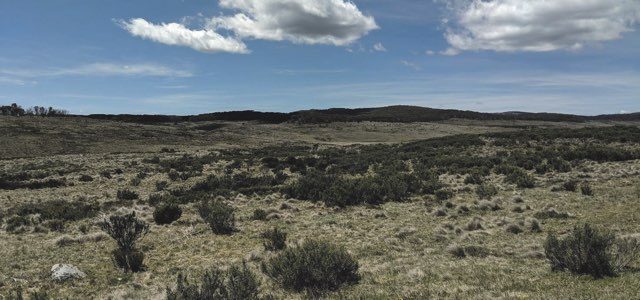
View of the Plateau landscape, where majority of surface elements have been avoided
Hazards
Potentially hazardous impacts of the project and public safety risks, including bushfire and flooding risks have been assessed. One of the key challenges for management of hazards and bushfire for the project is that the Snowy 2.0 Main Works are in a remote location within the KNP and existing access is constrained by topography and limited existing road infrastructure. Mitigation measures have been identified to enable the project to achieve compliance with the relevant requirements for bushfire protection such as establishing asset protection zones, bushfire refuges, and maintaining emergency access and egress routes.
Air
Potential air quality impacts from the project relate to increased dust generated during construction activities, particularly by increased traffic on access roads. The assessment showed that the predicted dust impacts were below the impact assessment criteria at most assessment locations. The exception is the Wares Yards Campground, where the criteria was modelled to be exceeded on two days in a year. Some exceedance was also noted at the Lobs Hole and Tantangara accommodation camps, and recommendations for mitigation to focus on the control of dust from unpaved roads close to the camps is recommended.
Social
Overall, construction of Snowy 2.0 Main Works will generate both positive and negative social impacts, and people within the community are generally both supportive of the Snowy 2.0 project and informed about how their community may be impacted. There is an expectation within the community that the project provides economic benefit to the localities within the area of influence and the community recognises the economic activity already being generated from work on the project thus far.
The key social impacts described relate to positive economic benefits, but also negative impacts associated with housing affordability and increased demand for access to community services and infrastructure. It is important for the project to monitor social changes relating to these potential impacts and consult with relevant government agencies to provide a collaborative response if needed, to social impacts.
As the project will be built and operated within KNP, recreational users of KNP will also experience social impacts. On balance, these short term impacts are considered acceptable on the basis that:
- long term impacts will be positive such as improved access and recreational facilities at Lobs Hole and improved access along Tantangara Road for recreational users;
- the closure of Tantangara Road has been limited to a period of nine months, which does not fall over the busiest period of January to April and public access will be facilitated for the remainder of the construction period;
- most impacts, once mitigation strategies are implemented, will be low; and
- displacement, both temporary and long term, is not expected to occur at high levels and will be to sites that generally have the capacity to absorb some extra visitation.
Economics
The economic impacts of the project have been assessed and are shown to be positive for all regions and economic measures.
Snowy 2.0 Main Works will deliver substantial economic benefits to the local region, NSW and NEM states more broadly, with key drivers being the direct investment to establish the project, wage expenditure, reduced ongoing electricity fuel costs, and reduced electricity costs. The greatest effect will be experienced by the NSW/ACT economies with gross state product expected to increase by $2,692 M. The aggregated beneficial effect across the remaining NEM participants is predicted to be an increase in GSP of $4,176 M. The local economies of Snowy Monaro Regional and Snowy Valleys LGAs will also benefit from Snowy 2.0 Main Works, increasing the average annual additional wage expenditure in the regional economy by $8 M.
Overall, economic impacts of Snowy 2.0 Main Works on the regional economy, NSW and NEM states are predicted to be substantial. These benefits are in addition to the economic benefits of Exploratory Works which are currently being realised, particularly in the regional economy.
Evaluation
The overall impacts and benefits of the Snowy 2.0 Main Works have been assessed in the EIS with regard to strategic need, environmental, social and economic impacts.
Snowy 2.0 Main Works has been developed with underpinning principles to avoid and minimise environmental impacts where possible and has been implemented through an iterative design and assessment approach. This approach has resulted in significant environmental improvements and outcomes as described in the EIS and supporting Project development and options report. In addition to avoiding and minimising impacts, the project has also provided significant contribution to scientific and cultural knowledge within KNP through extensive archaeological field survey, terrestrial and aquatic ecological survey, and ground and surface water monitoring.
Engagement with stakeholders and government agencies remains a priority for Snowy Hydro as key matters raised during the preparation of the EIS will require ongoing consultation. These matters include potential impacts to local water quality during construction, potential impacts on reservoir water quality from the excavated material placement, impacts on native and threatened species, and traffic impacts across the project. As the landowner of KNP, consultation with NPWS is fundamental and integral to the development of key actions to be implemented by the Offset Strategy to enhance the values of KNP.
Snowy Hydro has responsibly and carefully operated the Snowy Scheme in KNP for decades and will continue to act in an environmentally responsible manner throughout the construction and operation of Snowy 2.0.
Snowy Hydro has responsibly and carefully operated the Snowy Scheme in KNP for decades and will continue to act in an environmentally responsible manner throughout the construction and operation of Snowy 2.0. Some of the key long-term benefits that will be provided by the Snowy 2.0 Main Works to the KNP and local region include improved infrastructure, enhanced recreational areas, contributions to scientific research within the KNP, provision of funding for biodiversity offsets and creating economic growth in the region.
Snowy 2.0 has strong support from the community with consultation identifying the public expect the project will contribute to goals of the community including reliability in the electricity network, lower energy prices, increasing and expanding sources of reliable, renewable energy and minimising reliance on fossil fuels, minimising environmental impacts and providing economic benefits to local communities. Snowy Hydro will continue to consult and engage with the stakeholders as the Snowy 2.0 Main Works progresses through the assessment phase, and if approved, through the construction phase.
Overall, the project will provide:
- 2,000 MW of dispatchable generating capacity and approximately 350,000 MWh of storage available to the NEM, enough to ensure the stability and reliability of the NEM even during prolonged weather events, such as wind or solar 'droughts';
- increased security and reliability of supply, firm capacity for more variable and lower energy costs which will ultimately benefit consumers;
- social and economic benefits to the region; and
- positive contribution to knowledge about the environmental values of the KNP.
In addition, through the implementation of proposed mitigation, management and offsetting measures, the EIS demonstrates that Snowy 2.0 Main Works could be undertaken without any significant long term impacts on the local environment. As such, Snowy 2.0 Main Works is considered to be in the public interest.

View of Cooma from Nanny Goat Hill Lookout
Links to additional information
- Snowy 2.0 - Main Works: NSW Department of Planning and Environnment
- Snowy 2.0 - Exploratory Works: NSW Department of Planning and Environment
- Snowy 2.0 Exploratory Works EIS: Snowy Hydro / EMM Consulting
- Downloads

